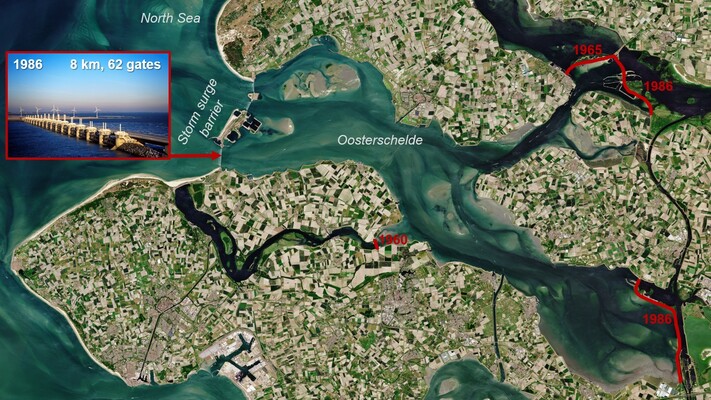P.L.M. de Vet 1*, B.C. van Prooijen 2, P.M.J. Herman 1,2, T.J. Bouma 3,4,5, D.S. van Maren 1,2, B. Walles 3, J.J. van der Werf 1,6, T. Ysebaert 3,7, E. van Zanten 8, Z.B. Wang 1,2
1 Deltares; 2 TU Delft; 3 NIOZ & Utrecht University; 4 HZ University of Applied Science; 5 University of Groningen; 6 University of Twente; 7 Wageningen Marine Research; 8 Rijkswaterstaat.
* Corresponding author: Lodewijk.deVet@Deltares.nl
Introduction
The Oosterschelde (Eastern Scheldt) tidal basin, located in the Southwest of the Netherlands, contains extensive (100 km2) intertidal flats serving as vital foraging grounds for migrating birds. The 8 km long storm surge barrier (1986) and closure dams (Figure) ensure flood safety while maintaining the open tidal connection with the North Sea. Nevertheless, the storm surge barrier and closure dams reduced the tidal prism – the amount of water flowing through the estuary – by 30% (Vroon, 1994). As a result, the equilibrium volume of the Oosterschelde’s channels (a function of the tidal prism) reduced. The channels have been facing a sediment deficit of 400-600 million m3 after the construction of the storm surge barrier (Mulder and Louters, 1994), known as “Zandhonger” in Dutch. Consequentially, the tidal flats in the Oosterschelde have been eroding ever since. As the total volume of sediment in the tidal flats is only a fraction of the channels’ sediment deficit and with sea levels rising, the future fate of the tidal flats is in question.
Objective and Methods
This study unravelled the adaptation of the tidal flat morphology and channels’ sediment deficit after constructing the storm surge barrier from extensive field measurements. By combining the strengths of independent morphology datasets, we ensured a cross-validation of observations and complementary insights. For example, triennial Vaklodingen elevation maps captured the whole Oosterschelde, whereas annual RTK-dGPS transects provided more precise bed elevation time series at specific locations. Further details are documented in De Vet et al. (2024).
These measurements revealed the morphological state of the system (e.g., tidal flat volume and elevation evolution) and allowed for an assessment of the evolution of the channels’ sediment deficit. We considered changes in both (1) channel volume and (2) equilibrium channel volume (through changes in tidal prism) resulting from (a) tidal flat erosion and (b) sea level rise. In this way, we could pinpoint whether the channels’ sediment deficit changed over time and by which mechanisms.
Results
The intertidal flats of the Oosterschelde have been eroding and flattening since the completion of the storm surge barrier. Despite the major channels’ sediment deficit, the datasets indicate a ~30% decay in erosion over the past decades. Apart from tidal flats adapting to post-barrier hydrodynamics and storm impacts, we identified contrary to previous perceptions a ~35% reduction in the channels’ sediment deficit (i.e., a reduced demand for sediment from the flats). The volume of the channels barely changed so far. Instead, the channels’ sediment deficit reduction resulted almost solely from changes in the channels’ equilibrium volume, demonstrating the relevance of post-barrier gains in tidal prism. Tidal flat erosion caused most of these tidal prism gains (more water enters the estuary with lower flats). However, the influence of sea level rise on the tidal prism is increasing with the reduction of the tidal flat erosion. While the reducing channels’ sediment deficit is good news regarding reducing tidal flat erosion, sea level rise remains increasing tidal flat submergence and pressuring the existence of these vital foraging grounds.

Overview of The Oosterschelde with its storm surge barrier and closure dams (indicated with the red lines, including years of completion). Satellite picture, credit: Copernicus Sentinel data (2020), processed by ESA, CC BY-SA 3.0 IGO.
References
De Vet, P.L.M., Van Prooijen, B.C., Herman, P.M.J., Bouma, T.J., Van Maren, D.S., Walles, B., Van der Werf, J.J., Ysebaert, T., Van Zanten, E., Wang, Z.B. (2024). Response of estuarine morphology to storm surge barriers, closure dams and sea level rise, Geomorphology. https://doi.org/10.1016/j.geomorph.2024.109462
Mulder, J.P.M., Louters, T. (1994). Changes in basin geomorphology after implementation of the Oosterschelde Estuary project. Hydrobiologia. https://doi.org/10.1007/BF00024619
Vroon, J. (1994). Hydrodynamic characteristics of the Oosterschelde in recent decades. Hydrobiologia.










